
The Atari 2600 is a home video game console developed and produced by Atari, Inc. Released in September 1977 as the Atari Video Computer System, it popularized microprocessor-based hardware and games stored on swappable ROM cartridges, a format first used with the Fairchild Channel F in 1976. The VCS was bundled with two joystick controllers, a conjoined pair of paddle controllers, and a game cartridge—initially Combat and later Pac-Man. Sears sold the system as the Tele-Games Video Arcade. Atari rebranded the VCS as the Atari 2600 in November 1982, alongside the release of the Atari 5200.

The Atari 7800 ProSystem, or simply the Atari 7800, is a home video game console officially released by Atari Corporation in 1986 as the successor to both the Atari 2600 and Atari 5200. It can run almost all Atari 2600 cartridges, making it one of the first consoles with backward compatibility. It shipped with a different joystick than the 2600-standard CX40 and included Pole Position II as the pack-in game. The European model has a gamepad instead of a joystick. Most of the early releases for the system are ports of 1981–1983 arcade video games. The final wave of 7800 cartridges are closer in style to what was available on other late 1980s consoles, such as Scrapyard Dog and Midnight Mutants.
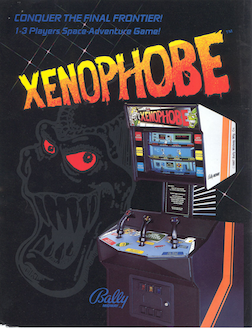
Xenophobe is a video game developed by Bally Midway and released in arcades in 1987. Starbases, moons, ships, and space cities are infested with aliens, and the players have to kill the aliens before each is completely overrun. The screen is split into three horizontally-scrolling windows, one for each of up to three players, yet all players are in the same game world.

The Atari XE Video Game System is an industrial redesign of the Atari 65XE home computer and the final model in the Atari 8-bit computer series. It was released by Atari Corporation in 1987 and marketed as a home video game console alongside the Nintendo Entertainment System, Sega's Master System, and Atari's own Atari 7800. The XEGS is compatible with existing Atari 8-bit computer hardware and software. Without keyboard, the system operates as a stand-alone game console. With the keyboard, it boots identically to the Atari XE computers. Atari packaged the XEGS as a basic set consisting of only the console and joystick, and as a deluxe set consisting of the console, keyboard, CX40 joystick, and XG-1 light gun.

Jr. Pac-Man is an arcade video game developed by General Computer Corporation and released by Bally Midway in 1983. It has the same gameplay as prior entries in the series, but the maze in Jr. Pac-Man scrolls horizontally and has no escape tunnels. The bonus item which moves around the maze changes dots into a form which slows Jr. Pac-Man as they are being eaten.

Food Fight is an arcade video game developed by General Computer Corporation and released by Atari, Inc. in March 1983. The player guides Charley Chuck, who is trying to eat an ice cream cone before it melts, while avoiding four chefs bent on stopping him. 1,951 arcade cabinets were sold.

Commando, released as Senjō no Ōkami in Japan, is a vertically scrolling run and gun video game released by Capcom for arcades in 1985. The game was designed by Tokuro Fujiwara. It was distributed in North America by Data East, and in Europe by several companies including Capcom, Deith Leisure and Sega, S.A. SONIC. Versions were released for various home computers and video game consoles. It is unrelated to the 1985 film of the same name, which was released six months after the game.

Crossbow is a light gun shooter released as an arcade video game by Exidy in 1983. It was later published by Absolute Entertainment for the Commodore 64 and MS-DOS, and by Atari Corporation for the Atari 2600, Atari 7800, and Atari 8-bit computers starting in 1987. The game is controlled via a positional gun that resembles a full-sized crossbow.
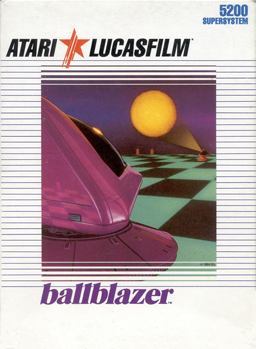
Ballblazer is a futuristic sports game created by Lucasfilm Games and published in 1985 by Epyx. Along with Rescue on Fractalus!, it was one of the initial pair of releases from Lucasfilm Games, Ballblazer was developed and first published for the Atari 8-bit computers. The principal creator and programmer was David Levine. The game was called Ballblaster during development; some pirated versions bear this name.

Summer Games is a sports video game developed and published by Epyx based on sports from the Summer Olympic Games. Released in 1984 for the Commodore 64, it was ported to the Apple II, Atari 2600, Atari 7800, Atari 8-bit computers, and Master System.

The Atari Flashback is a line of dedicated video game consoles produced since 2004, currently designed, produced, published and marketed by AtGames under license from Atari SA. The Flashback consoles are "plug-and-play" versions of the 1970s Atari 2600 console with built-in games rather than using ROM cartridges. The latest home console model, Atari Flashback 12 Gold, was released in 2023 and has 130 games.

The Atari XG-1 light gun is a video game controller which was released in 1987. Atari's only light gun, it is compatible with the Atari 8-bit computers, Atari 7800, and Atari 2600. It was bundled with the Atari XEGS Deluxe home computer and video game console combination system, and with the light gun game Bug Hunt for the 7800 as model XES2001 for US$34.95. Atari eventually released five light gun games on the 7800 and one on the 2600 (Sentinel).

Starship 1 is a first-person shooter space combat game developed and manufactured for arcades in 1977 by Atari, Inc. The game, which takes great inspiration from the television series Star Trek, contains the first known Easter egg in any arcade game. The arcade game was distributed in Japan by Namco in 1978, and was ported to the Atari 2600 as Star Ship.
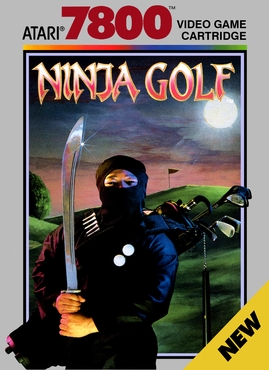
Ninja Golf is a beat 'em up/golf video game developed by BlueSky Software and published by Atari Corporation for the Atari 7800. Gameplay consists of the ninja player character hitting a golf ball at the beginning of each hole (stage) then fighting various enemies in side-scrolling sections to reach it. Each green is guarded by a fire-breathing dragon boss that the player must defeat by throwing shurikens.

Dandy is a dungeon crawl maze video game for Atari 8-bit computers published by the Atari Program Exchange in 1983. It is one of the first video games with four-player, simultaneous cooperative play. Players equipped with bows and unlimited arrows fight through a maze containing monsters, monster spawners, keys, locked doors, food, and bombs in search of the exit leading to the next level. If a player dies, they can be revived by finding and shooting a heart. The game includes an editor for making new dungeons.

Space Gun is a 1990 first-person shooter arcade game released by Taito. The game is set aboard a crippled space station that has been overrun by hostile alien creatures. The objective is to rescue human crew members while destroying the alien creatures. The game lets the player shoot limbs off the creatures, resulting in blood splatters.

Alien Brigade is a horizontally-scrolling rail shooter released by Atari Corporation in 1990 for the Atari 7800. Similar in style to Operation Wolf, Alien Brigade tells the story of a soldier battling with alien invaders that take over the bodies of fallen soldiers.
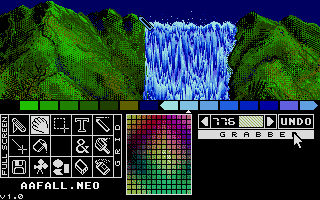
NEOchrome is an early color bitmap graphics editor for the Atari ST. It was written by Dave Staugas, a programmer at Atari Corporation and co-author of the ST's operating system. NEOchrome supports hardware-supported color cycling to give the impression of animation. A color cycling waterfall, created with NEOchrome, was one of the iconic images of the early Atari ST.
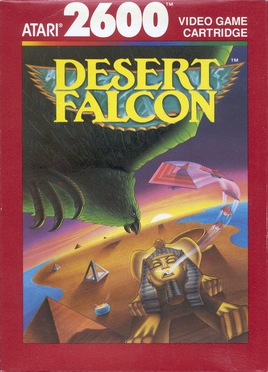
Desert Falcon is a scrolling shooter developed by General Computer Corporation for the Atari 7800 and Atari 2600 and published by Atari Corporation in 1987. It was initially announced in 1984, prior to being named Desert Falcon, as one of the planned launch titles for the 7800. A cartridge version for Atari 8-bit computers, with XEGS-styled packaging, followed in 1988.
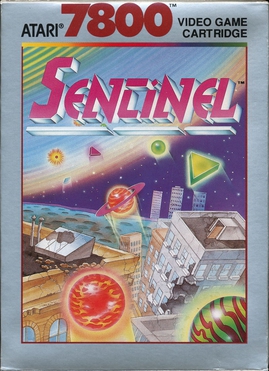
Sentinel is a 1990 video game developed by Imagineering and published by Atari for the Atari 2600. It is the only light gun game ever released for the Atari 2600 platform. It was re-released with improved graphics for the Atari 7800 in 1991.




















